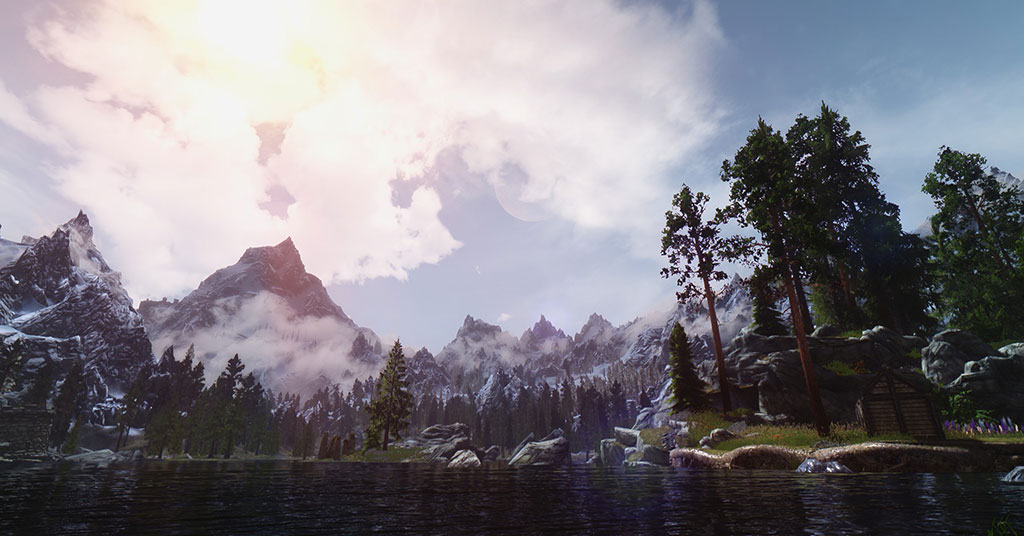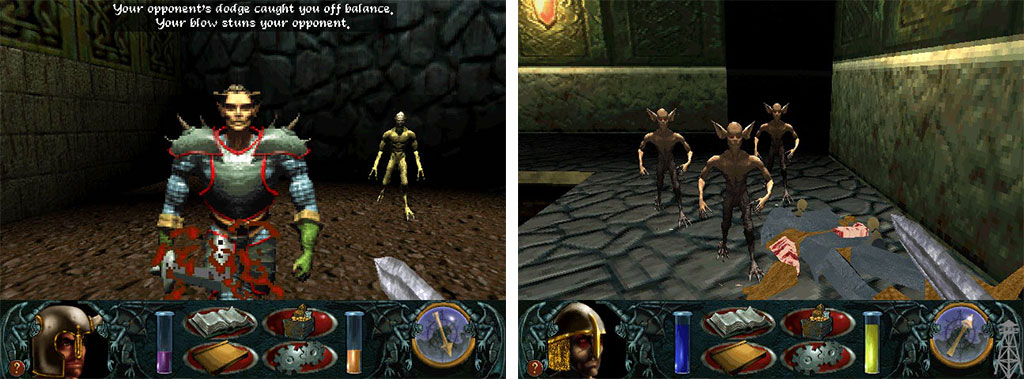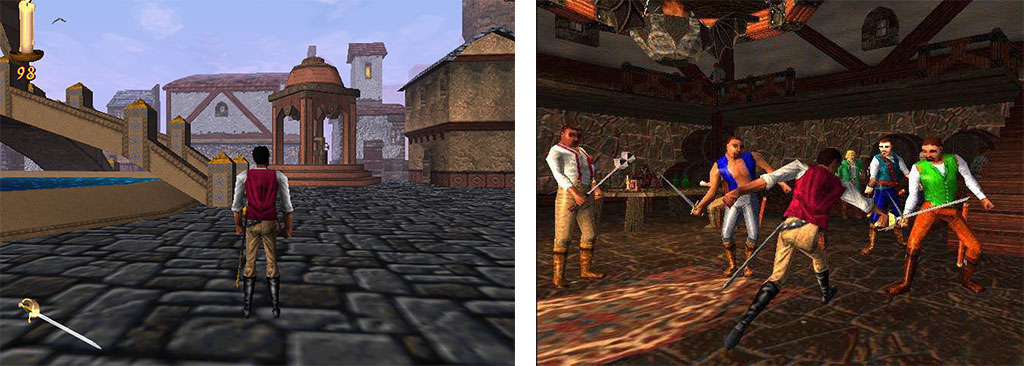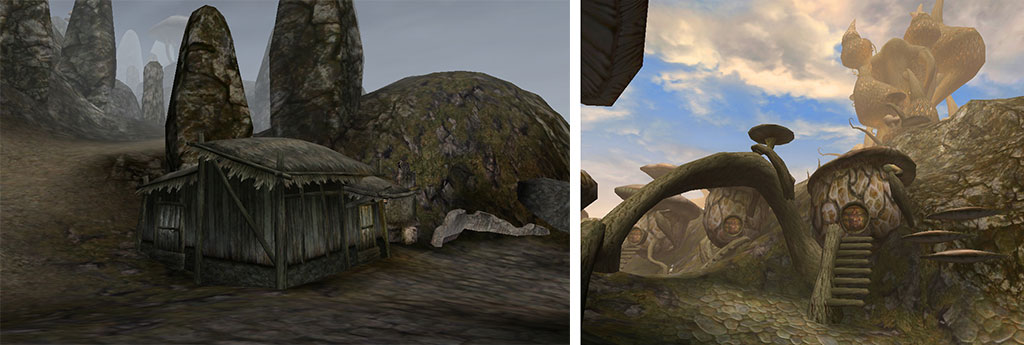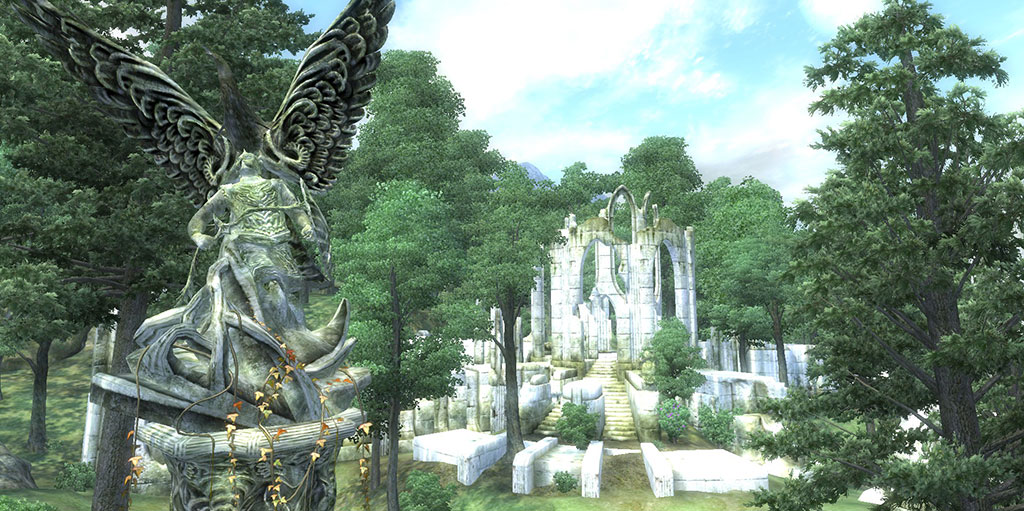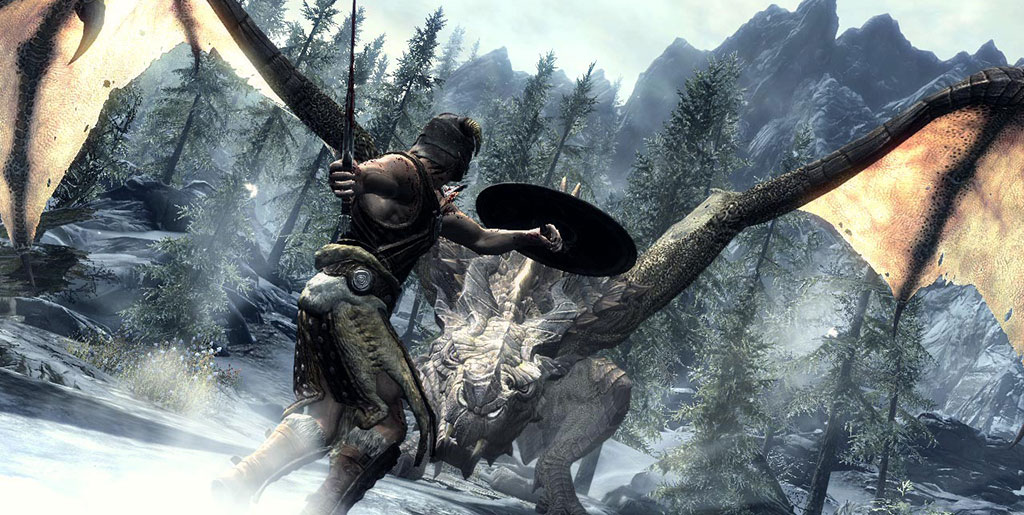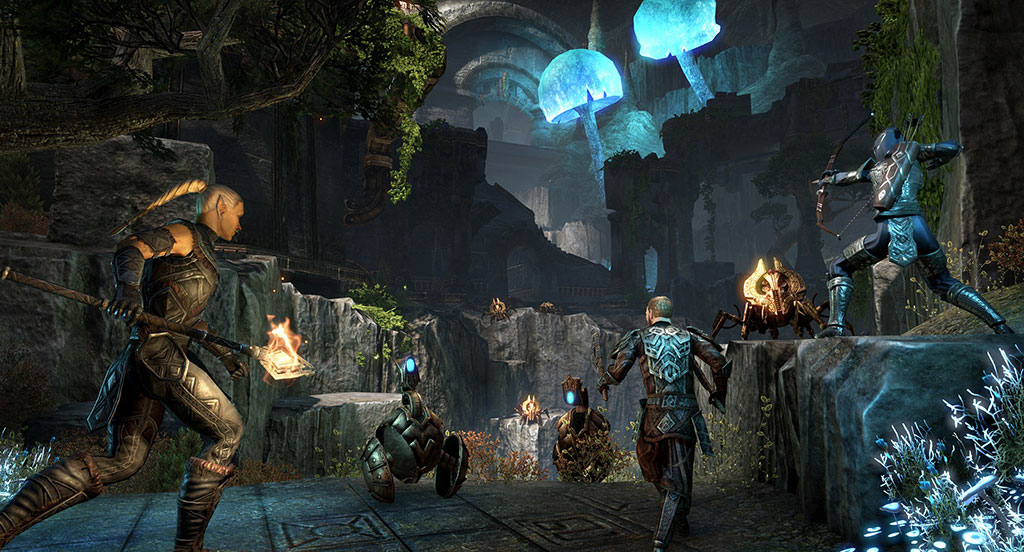Taking a Look at the History of the Elder Scrolls Series
The beginning of a legend:
The Elder Scrolls series had very humble beginnings. In fact, at Arena’s launch Bethesda was highly limited in terms of distribution, due to missed deadlines, a rather risque cover image (for the time,) and a general idea that games wouldn’t sell as well away from the Holidays. This was so much a concern, that there was a limitation placed upon the initial product shipment. However, innovation and hard work are often rewarded, and as word of the game spread, it quickly became a massive success. From there on, competition and other sources of inspiration would transform the series from something closer to resembling the RPG heritage, to the more free-form exploration and action games that would become the Elder Scrolls formula for the past 15 years.
The original idea for Arena wasn’t even an RPG as we know it. Instead it was to be a tournament themed game, with the occasional side quest. It is interesting to note that the original design would have been something completely different. After all, the introduction of Arena had a profound influence on RPGs in the coming decades. The name Arena comes from that tournament theme. Materials had already been printed using this name, so changing it on the fly, with all kinds of physical materials out there already, was not acceptable. Instead, Bethesda came up with the addition of “The Elder Scrolls.”
Arena:
Arena took a lot of ideas from the pen and paper roleplaying systems. It used a wide stat array, and offered classes to define what a character was going to do. The game brought new ideas, such as movement not tied to a grid system, to the space of 2.5D gaming. Arena featured many systems destined to change over the course of the series, such as fatigue. However, it also introduced some ideas that would be refined but never scrapped, such as quests with a number of potential randomized locations.
The gameplay was fairly simple at this point. Spells from a window could be selected to be cast. Attacks in a few directions could be used. No looking up or down was allowed, as this was 2.5D! Yet it was also so much more than the tiny and linear worlds which had dominated the genre. Arena had big towns, and plenty of adventure to offer. Those who followed the quest path would eventually put the empire to rights, which was simply defined at this point as the empire. The intrigue and politics that seem so openly embraced in later games just weren’t involved in Arena, outside those of the main villain.
Arena noted that you were locked up for being a potential threat, but the jailers involved seemed rather odd. After all, they left you the key to your cell in your cell, and then abandoned the defenses to rats and goblins. Still the starting dungeon was notably harsh. Your character had no regeneration outside resting, plenty of foes to clear out to get a rest spot, and a high chance of being disturbed if you didn’t use special alcoves.
Daggerfall:
Daggerfall worked along very similar lines to Arena. You were an agent of the empire. This time, however, the starting dungeon wasn’t explained nearly as well. You just were there, despite your mission for the empire, in an even tougher initial dungeon which left many players frustrated. Bugs plagued the game, although they were quickly given patches.
One of the things which remained was zombies. Zombies with health pools easily more than ten times the health pools of any other foe. Along with random dungeon and quest foes scaling to you, this meant sometimes backtracking to an earlier save was the best option.
Even so, Daggerfall had a lot going for it. It expanded upon the systems of Arena, and used a true 3D engine allowing looking up and down. It used levers and secret doors throughout the game world, along with offering an incredibly large world and a storyline that was hand designed with static foe difficulty. It improved on many previous aspects, adding depth to alchemy and spell creation, and giving exploration and freedom to the player, even more than Arena. You could now buy a house in any town with a bank, meaning you could make yourself feel at home. Perhaps most importantly, Daggerfall introduced the skill based level system that would become a standard in the series.
Battlespire:
Battlespire was originally just an extremely long Daggerfall dungeon. After a little consideration, however, it became a game unto itself. With small limited maps on a linear progression, it was a very different experience than the previous games. Sadly it suffered all the worst combat issues of prior games, but in a dungeon environment that was slightly more open and harder to defend oneself within. Probably the low point of the series, it nonetheless did provide some technical improvements with the combat systems and interior spaces of the series.
Redguard:
The most underappreciated award of the series should go right here. Redguard was different than anything else in the series, a preset adventure on the island of Stross M’Kai which featured upgraded graphics beyond Daggerfall, offered an interesting combat system, and most importantly proved that such an experience could be extremely smooth.
The small size, and lack of character freedom/exploration are highly noted as reasons why this title didn’t do well. Fans expected another game like the previous entries. Instead, Redguard was an action adventure on modest rails, with puzzles and swashbuckling. It stepped away from what defined the other games, and fans didn’t respond well.
However, Redguard was smooth as silk. It was an incredibly well crafted experience, offering some of our first looks at a true 3D experience with terrain that changed, combat that included some physics, and a solid storyline. Sadly, playing the game on current systems using Dosbox doesn’t result in that same experience, as the engine just does not respond well. A patient player may still enjoy the game, but with moments of lag the combat and puzzles can become very painful.
Morrowind:
Change was upon the wind. Namely, engine changes. After the release of Gothic and Gothic 2 by German studio Piranha Bytes, with their custom engine, advanced character models (by comparison) and other technological advances, the 3DFX engines just weren’t going to cut it. Morrowind adopted the change to Gamebryo, followed by their competition in Gothic 3. Both games used the new engine to achieve some of the most realistic looking character models and world graphics of the time, with each also making some changes to their combat systems and even introducing things like arrow physics to the gaming world.
Morrowind reduced the original scope to compensate for requiring far more detail. Where previous games had been largely computer generated, now The Elder Scrolls was working largely with hand-made designs. The result was the island of Vvardenfell. Perhaps it was smaller, but fans of the series found that there was still exploration and discovery alongside a world that looked far better. It was an instant hit, one which is considered a favorite of many.
Morrowind started the journey from the older titles to the newer titles. It pushed away some of the old ideas, which we later see vanish from the series, replacing them with things which are more convenient to the player. It also changed the fatigue system, which limited how long players could have their character stay awake, to the stamina system.
Still buggy, and with far too many Cliff Racers, Morrowind was nonetheless an addition which helped propel the series onward. Whether some of the old mechanics are things that older gamers might miss to this day or not, it cannot be argued that the removal of some of the complexities and inconveniences of playing pushed the series more into the mainstream.
Oblivion:
Oblivion continued working on all the things Morrowind had done. It pushed farther into the current design mold, and updated the graphics and physics engines. It also restored, a little, the idea of computer generated world effects, given new technologies and coding which allowed for more realistic terrain to be made via a generator algorithm.
The technological advances of Oblivion set the stage for Skyrim. Oblivion itself spent more time focusing on the story, improving the UI, and making everything from Morrowind feel just a little more refined, while also trying to make the world slightly larger once again. A particularly notable improvement for many was the enhancement of sight distance, allowing for players to see landscapes and towns from far away.
Skyrim:
Skyrim continued the same trend, pushing forward with the action themed combat design and convenience features that had been slowly introduced throughout the series. Again the focus was largely upon making the world more beautiful and larger. However, in the case of Skyrim a few other choices were made such as making the UI as minimalist as possible.
One notable feature that vanished with Skyrim was spell crafting. Where prior games had encouraged the player to craft spells with different effects, this was removed in Skyrim. That along with poor spell scaling left magic feeling underwhelming, where before it had been perhaps too strong. Where the balancing issues with such a feature are easy to understand, the results are one of the many places where fans have noted Skyrim was lacking.
Even so, Bethesda once again met most of their goals, expanding the world size (minus invisible walls) and producing better graphics, physics, and world environment than previous entries in the series. Skyrim also expanded slightly on some other areas of the game world, such as housing.
Online:
The Elder Scrolls Online (ESO) is a return to trying something different. As an MMO it was never going to be exactly the same as the most recent single player games in design, although it did borrow much of the UI from Skyrim. For many fans, some of the failures to match up with the older games were of great note and sorrow. These include plot lines that seem to conflict with some other points, game system changes, a lack of explanation for where these events fade from history, and a notable shift in the world map, specifically around Daggerfall. Where these changes are all possible, they do raise many questions about how the lore from the timeline of ESO reaches that of the other games.
Over the course of time, ESO has evolved to try to become something closer to the normal Elder Scrolls experience. Changes have included work to minimize the linear nature of levels in the game with regard to areas in the game, work on making exploration and thievery work, and housing. In fact, thievery actually requires somebody around to notice in ESO, a vast improvement from the mysterious Omniscience of npcs about who stole their stuff in Skyrim.
Most recently ESO had chosen to return to Vvardenfell. How true this representation, and how much may have changed in history and lore, is something that will surely be debated across the internet. Get your popcorn ready folks, somebody is sure to be wrong!
Wrapping up that history:
With so much to go over, there are a few things that I still felt needed some attention. Lore, for example, isn’t really something I covered here. There’s a ton of it, and there are many places to read up on the stories and world of Tamriel.
Another thing I feel the need to mention is that many of the older games are free. They can be played on Dosbox, which can run on Windows and Android. So yes, you can play them on some smartphones. To prove this, I ran Daggerfall on my 4 year old tablet. It works, but without something for binding keys to my tablet was a poor choice. I highly recommend having some sort of keyboard for your phone or tablet if you try this!
Additionally, many of the older games had some nudity involved. This is important, because the child safety features were usually something accessed during installation (and didn’t really prevent the nudity so much as some content.) So be careful when introducing these games to people who might not find that a good fit, and to younger gamers!
Looking forward:
Rumors are all we really have with regard to the future of the series as a whole at this time, but we do know that TES6 is planned. Where spell making and some of the complexities of the older games won’t likely return, there are some speculations on where Bethesda may look to expand the experience.
Certainly there are sources of inspiration available. There’s the Witcher 3, Horizon: Zero Dawn, and a handful of other games which may provide some ideas, as well as their own work on Fallout 4 and ESO.
One thing that we know for certain is that they were not satisfied with the end result of magic in Skyrim. It isn’t clear if they will opt for scaling mechanics or some greater overhaul.
For now, though, Vvardenfell awaits. I may even see you there, as we all keep a close eye on the skies for swarms of cliff racers!
About the Author
Jairone
Senior Editor
Robert joined Gaiscioch during the Rift chapter, and decided to stick around because the people are awesome! He has a long history of playing games, mostly RPG or Strategy, and has played MMOs since they were born of MUDs.
Aside from his gaming, he also enjoys reading and cooking. Robert has also been previously published as a contributor with Rift Junkies for several articles during the 'Storm Legion' expansion. He does not always use the moniker 'Jairone' but it is a frequent choice in honor of one of his Grandfathers, as it is based on his middle name of Jerome.

